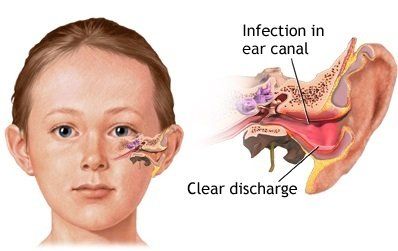Earaches & Ear Infections
Ear infections occur in a variety of ways, and can happen internally, in the middle ear, or the outer ear. Because of the wide range of bacteria and viruses that can afflict different segments of the ear, it is important to pay special attention to the severity of your symptoms to help our Ear Nose & Throat specialists determine the correct course of treatment.
The Types of Ear Infections are as follows:
Internal Ear Infection (Otitis Interna)
This usually occurs when the inner ear is inflamed due to a virus, but may also be caused by middle ear bacteria spreading to the inner ear. Symptoms include sudden onset of severe vertigo, nausea, and vomiting, and are sometimes so severe that emergency room care and medication are required to control the vertigo.
Middle Ear Infection (Otitis Media)
Middle ear infections are very common in childhood but can occur at any age, and are usually accompanied by an upper respiratory tract infection with coughing and nasal discharge. These infections are most commonly caused by a blockage of the Eustachian tube, which creates swelling in the mucous membranes. Antibiotic treatment is the best course of action in these cases.
Outer Ear Infection (Otitis Externa):
When the outer ear and ear canal are inflamed, this “earache” is commonly referred to as “swimmer’s ear.” The skin in the ear canal becomes inflamed, swells, and is tender to the touch. Outer ear infections can be caused by polluted water entering the ear canal, particularly when the skin has slight tears that allow for bacteria and fungus to grow. This is the only type of ear infection that is visible with the naked eye.
Treatment of Earaches and Ear Infections
Our Ear Nose & Throat specialists will assess the health of the ear with an otoscope, looking specifically for fluid behind the eardrum and redness of the ear. Tone testing, such as an audiogram, or air-pressure tests like tympanograms, may also be performed to better understand the effects of the infection.
Antibiotics, antihistamines, decongestants, or eardrops may be prescribed, and in some instances, ear-tube surgery may be recommended.
Don’t hesitate to make an appointment with us for yourself or a loved one. The sooner a thorough examination can take place, the sooner we can help relieve the pain and discomfort of the infection.
Swimmer’s Ear
Swimmer’s Ear is a common condition that can affect those who swim often or anyone with open exposure to high levels of water, sand, dust or dirt. This condition, called otitis externa, is a fungal or bacterial infection of the outer ear canal commonly referred to as an earache.
“Swimmer’s ear” doesn’t just affect swimmers. Improper use of cotton swabs, insertion of foreign bodies (like peas) into the ear, and damage to the outer ear can all cause a case of otitis externa.

Why Is It Called Swimmer’s Ear?
Swimmer’s ear gets its name from one of its most common causes: swimming. When bacteria from polluted water enters the ear, it can settle in and cause infection. Even swimming pool water can carry bacteria.
Swimmer’s Ear Symptoms
The most obvious sign of an outer ear infection is pain, but there are other signs as well:
- Drainage from the ear
- Hearing loss
- Itchy ear or ear canal
- Peeling or shedding skin inside ear
Because swimmer’s ear is bacterial in nature, you’ll need to see a doctor to receive proper treatment.
Cleaning the Ear
Cotton swabs are often misused to clean the ear. It’s important to remember that nothing should ever enter the ear canal. Usage of cotton swabs merely impacts ear wax, or cerumen, which may cause pain, pressure, ringing, dizziness, and even difficulty hearing. More importantly, inserting a swab too far can damage, or even puncture, the eardrum. The ear is self-cleaning and ear wax is produced to catch dirt and serve as a protective layer and lubricant. Over time, the ear wax sloughs away on its own.
In the end, the body is built to naturally take care of itself. Cotton swabs have many uses, but cleaning your ears is not one of them. If you feel you have excess or impacted ear wax, please contact us and schedule an appointment with a medical professional.
Ear Tubes
What are Ear Tubes?
Ear infections. They can be frequent, and for many, they can be painful. This, for those who are parents already know too well, can be especially true for children.
Though viral ear infections tend to go away on their own and bacterial ear infections can be treated by way of antibiotics, chronic ear infections often lead to more severe complications. Speech complications, hearing loss, and even behavioral issues can be caused by persistent ear infections.
How Ear Tubes Can Help
ENTs specialize in these cases, and our recommendation is often ear tubes. Ear tubes are very small tubes that allow air to pass through the eardrum and into the middle ear to reduce the risk of infection.
There are two basic kinds of ear tubes:
- Short Term Tubes—tubes intended for six months to a year. These tubes are designed to fall out of the ears without professional intervention.
- Long Term Tubes—as their names describes, these are intended to stay in place for a longer period of time. Their specialized design keeps them in place. They may fall out on their own, but in some cases removal by an ENT is required.
Candidates for Ear Tubes
Though children most commonly need them, adults can benefit from ear tubes as well. You or a loved one may need ear tubes if your experience:
- Reoccurring middle ear infections
- Fluid in your middle ear
- Balance problems
- Hearing loss
- Speech difficulties
- Sleep problems caused by ear infections




